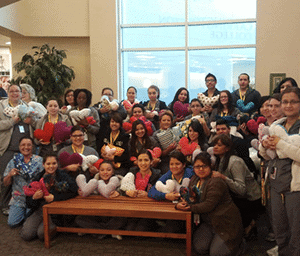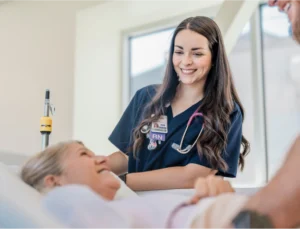 Every year the Carrington College Phoenix campus supports and promotes Congenital Heart Defect (CHD) Awareness Week (7th-14th February); it holds an event, the heart pillow project, that raises awareness and brings smiles to hundreds of children’s faces. This month, for the fifth consecutive year, students and staff will deliver home-made heart shaped pillows to 300 children at Phoenix Children’s Hospital (PCH).
Every year the Carrington College Phoenix campus supports and promotes Congenital Heart Defect (CHD) Awareness Week (7th-14th February); it holds an event, the heart pillow project, that raises awareness and brings smiles to hundreds of children’s faces. This month, for the fifth consecutive year, students and staff will deliver home-made heart shaped pillows to 300 children at Phoenix Children’s Hospital (PCH).
Patti Zint, Medical Assisting Program Director, explained a little more about the project.
This has been my pet project since I started it five years ago, and until this year I coordinated it. But to give my faculty a bigger role going forward, I asked Suzanne Reed, one of our Medical Assisting (MA) Instructors, to head up the project and coordinate our CHD Awareness event this year. It’s really a three phase, six-week process. Everyone on campus really gets involved in some way or another; it’s led by the Medical Assisting program but it is campus wide. We have an MA student whose son was born last year with a congenital heart defect; he is treated regularly at PCH and his mom has managed to keep going to school. When we talk about CHD to our classes, there are always students who share their stories about someone they know with a CHD – this condition really does impact many lives. Congenital heart defects are the most common type of birth defect in the United States, affecting 1 in 100 births per year, that’s around 40,000 babies each year. Information from the Congenital Heart Information Network confirms just how important it is to promote awareness of this condition – “Congenital Heart Defect is considered to be the most common birth defect and is a leading cause of birth-defect related deaths worldwide. Despite the fact that CHD affects approximately 1.8 million families in the U.S., a relatively small amount of funding is currently available for parent/patient educational services, research, and support.”
When did work on this year’s project start?
Phase one started just after we returned from winter break when we presented the idea to students, and started gathering fabric and fiber fill. The pillows are all cut, sewn, stuffed and stitched by students, staff and faculty. They are home-made from the heart; we attach cute little cards with words of inspiration, signed by the person who made it. That way the patients know that it comes with love from a person, not just an organization.
Phase two is all about raising awareness, so what do you do?
 Several years ago I reached out to Mended Little Hearts (MLH), inviting them to come and speak to our students. One guest speaker, Vanessa Blutrich, has been a featured speaker for the past four years. Each year she shares the story of her son, and explains how MLH reaches out to parents. Vanessa is one of three MLH speakers who came to campus for morning, afternoon and evening classes. To thank MLH for taking the time to educate our students, Suzanne made certain each speaker received heart pillows for the care bags they create – I think Suzanne has already sent off 50-100 pillows to MLH. Mended Little Hearts provides families and caregivers of children with heart defects and heart disease an outlet through which they can find answers, education, resources and access to local-based peer-to-peer support – building hope for the future. Through Mended Little Hearts, children and their families find strength and understanding from those who share the same experience.
Several years ago I reached out to Mended Little Hearts (MLH), inviting them to come and speak to our students. One guest speaker, Vanessa Blutrich, has been a featured speaker for the past four years. Each year she shares the story of her son, and explains how MLH reaches out to parents. Vanessa is one of three MLH speakers who came to campus for morning, afternoon and evening classes. To thank MLH for taking the time to educate our students, Suzanne made certain each speaker received heart pillows for the care bags they create – I think Suzanne has already sent off 50-100 pillows to MLH. Mended Little Hearts provides families and caregivers of children with heart defects and heart disease an outlet through which they can find answers, education, resources and access to local-based peer-to-peer support – building hope for the future. Through Mended Little Hearts, children and their families find strength and understanding from those who share the same experience.
Why do you feel it so important to bring in speakers from Mended Little Hearts?
If you can touch the heart of somebody, no pun intended, by listening to a very real story and seeing pictures of real children, or even meeting children who have gone through this, then it really makes these pillows, and why we do this, feel more real. As much as we’d like to, we can’t take 200 students to the hospital on delivery day. So it’s a very real way to get all our students involved – they can really see and imagine what someone goes through with CHD. That’s why we do this in phases; it gets everyone involved, not just the 15 who go to the hospital.
Phase three is the delivery of the pillows. What’s that day like?
We will have 300 pillows to take to the hospital on February 18th; enough for every patient – we don’t want anyone to go without. We walk right into the patients’ rooms and give the pillows out to the children and their families; that’s the tear-jerker part right there, when we see their faces. The pillow itself provides comfort to patients and their families; holding a pillow to a chest that has been opened up for surgery aids with the necessary coughing to clear the lungs. The look on the faces of the children who receive these pillows is wonderful!



